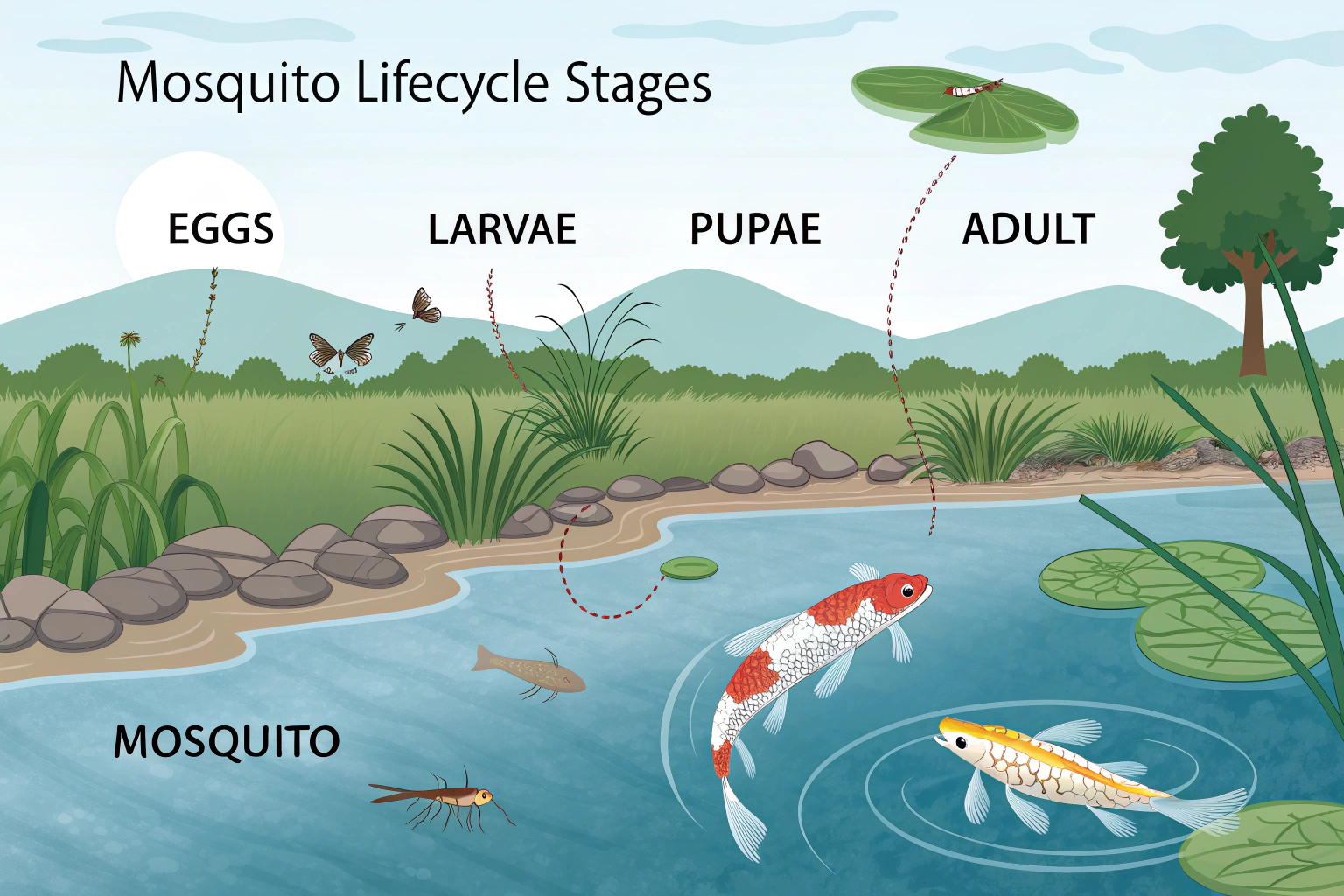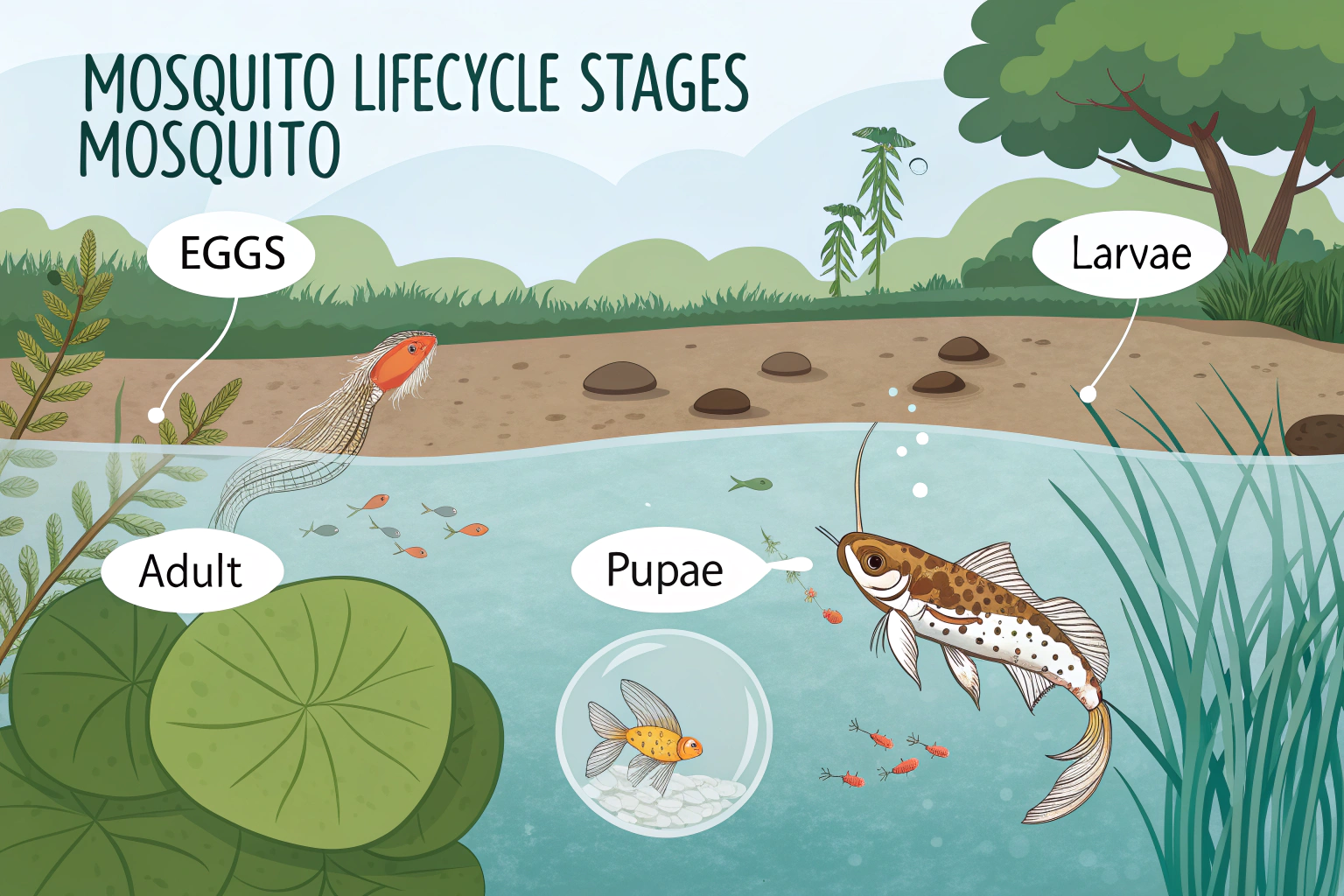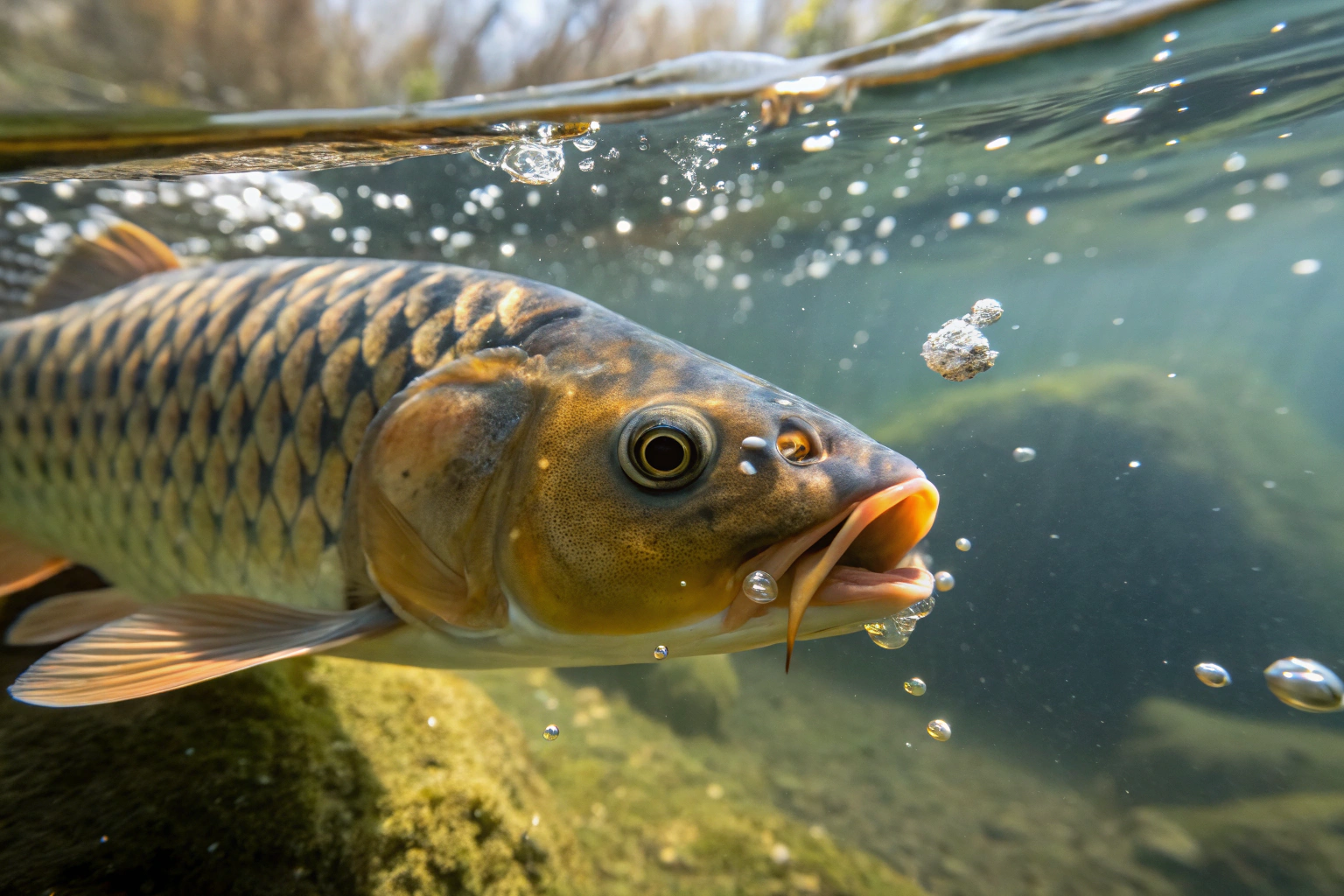Do Koi Fish Eat Mosquito Larvae? Natural Pest Control in Your Pond
This post may contain affiliate links.
If you’re a pond owner dealing with pesky mosquitoes, you’ve likely wondered whether your beautiful koi fish can help solve this buzzing problem. The short answer is yes – koi fish do eat mosquito larvae, making them an excellent natural pest control solution for your backyard pond. Understanding how this natural predator-prey relationship works can transform your pond maintenance strategy and significantly reduce mosquito populations around your outdoor space.

Understanding Koi Fish Feeding Behavior
Koi fish are omnivorous creatures with remarkably adaptable feeding habits. In their natural environment, these colorful carp species consume a diverse diet that includes both plant matter and small aquatic organisms. When it comes to mosquito larvae, koi fish view these wriggling creatures as an easily accessible protein source that perfectly fits their opportunistic feeding style.
The feeding behavior of koi fish is particularly interesting because they actively search for food throughout different water levels. Mosquito larvae typically float near the water surface or hang just below it, making them prime targets for hungry koi. This surface-feeding behavior makes koi fish especially effective mosquito larvae predators compared to bottom-feeding fish species.
According to research from the Journal of Vector Ecology, fish-based biological control methods can reduce mosquito larvae populations by up to 95% in controlled pond environments. This scientific backing supports what many pond owners have observed firsthand in their own water features.
The Mosquito Life Cycle and Your Pond
To understand how koi fish contribute to mosquito control, it’s essential to grasp the mosquito life cycle. Female mosquitoes lay their eggs in stagnant water, which then hatch into larvae within 24-48 hours. These larvae, commonly called “wigglers,” spend 7-10 days in the water before pupating and eventually emerging as adult mosquitoes.
Your pond provides an ideal breeding ground for mosquitoes if left unmanaged. The larvae feed on organic matter, bacteria, and algae in the water while developing through four distinct growth stages. During this vulnerable aquatic phase, mosquito larvae are completely dependent on the water environment – making them perfect targets for aquatic predators like koi fish.
Research from the Centers for Disease Control and Prevention indicates that eliminating mosquito larvae in breeding sites is one of the most effective long-term mosquito control strategies available to homeowners.

How Effective Are Koi Fish at Controlling Mosquitoes?
The effectiveness of koi fish as mosquito larvae controllers depends on several factors, including pond size, koi population, water temperature, and availability of alternative food sources. Under optimal conditions, a healthy population of koi fish can consume thousands of mosquito larvae daily, dramatically reducing the number of adult mosquitoes emerging from your pond.
Studies conducted by aquaculture specialists have shown that koi fish demonstrate remarkable efficiency in locating and consuming mosquito larvae. Their excellent eyesight and surface-feeding behavior make them natural mosquito larvae hunters. Additionally, koi fish are most active during dawn and dusk hours – precisely when mosquito larvae are most vulnerable and visible near the water surface.
However, it’s important to maintain realistic expectations. While koi fish significantly reduce mosquito larvae populations, they may not eliminate mosquitoes entirely. Factors such as overfeeding your koi, dense vegetation that provides larvae hiding spots, or extremely large pond systems can limit their effectiveness as standalone mosquito control agents.
Optimizing Your Pond for Natural Mosquito Control
Creating an environment where your koi fish can effectively control mosquito larvae requires strategic pond management. First, maintain appropriate koi stocking densities – generally 1-2 koi per 100 gallons of water. This ensures adequate fish population for larvae consumption without overcrowding your pond ecosystem.
Water circulation plays a crucial role in mosquito control effectiveness. Installing pond aerators or fountains creates water movement that disrupts mosquito egg-laying while simultaneously improving water quality for your koi fish. Moving water also helps distribute mosquito larvae throughout the pond, making them more accessible to hunting koi.
Vegetation management strikes a delicate balance in mosquito control. While aquatic plants provide beneficial ecosystem services, excessive vegetation can create protected areas where mosquito larvae develop undisturbed. Maintain roughly 60-70% open water surface to optimize koi fish hunting opportunities while preserving essential plant benefits.
The International Water Management Institute has published extensive research on biological pest control in aquatic systems, emphasizing the importance of balanced ecosystem management for sustainable mosquito control.

Additional Benefits of Koi Fish in Pond Ecosystems
Beyond mosquito larvae control, koi fish provide numerous ecological and aesthetic benefits to pond environments. These hardy fish consume various other pest organisms, including midge larvae, small gnats, and aquatic worms that can become problematic in pond systems. This comprehensive pest control capability makes koi fish valuable additions to any water feature.
Koi fish also contribute to nutrient cycling within pond ecosystems. Their feeding activities help control algae growth by consuming organic matter that would otherwise fuel algal blooms. Additionally, koi waste provides essential nutrients for aquatic plants, creating a balanced ecosystem that supports overall pond health.
From an aesthetic perspective, koi fish transform ordinary ponds into living art installations. Their vibrant colors, graceful swimming patterns, and interactive personalities create engaging outdoor spaces that increase property value while simultaneously providing practical pest control benefits.
Complementary Mosquito Control Strategies
While koi fish excel at consuming mosquito larvae, implementing complementary control strategies maximizes your pond’s mosquito-fighting potential. Installing solar-powered pond fountains or aerators creates continuous water movement that prevents mosquito egg-laying while supporting koi fish health through improved oxygenation.
Beneficial bacteria additives help maintain water quality while creating conditions that favor fish health over mosquito development. These biological treatments reduce organic matter that mosquito larvae feed on, essentially starving potential mosquito populations before they can establish themselves in your pond.
Strategic landscaping around your pond area can also contribute to mosquito control. Plants like lavender, marigolds, and citronella grass naturally repel adult mosquitoes, creating a multi-layered defense system that protects your outdoor living space.
The American Mosquito Control Association provides comprehensive guidelines for integrated pest management approaches that combine biological, physical, and environmental control methods for maximum effectiveness.

Seasonal Considerations for Mosquito Control
Mosquito activity and koi fish feeding behavior both fluctuate seasonally, affecting the dynamics of natural pest control in your pond. During warmer months, increased water temperatures boost both mosquito reproduction rates and koi fish metabolisms, generally favoring effective biological control.
Spring represents a critical period for mosquito control as warming temperatures trigger increased egg-laying activity while koi fish are just beginning to resume active feeding after winter dormancy. Supplementing natural control with physical methods like surface agitation can bridge this temporary gap in biological control effectiveness.
Summer months typically provide optimal conditions for koi fish mosquito control, with active fish consuming larvae at peak efficiency. However, drought conditions or extreme heat may concentrate mosquito breeding in your pond, potentially overwhelming even healthy koi populations.
Fall preparation involves gradually reducing koi fish feeding as metabolism slows, while mosquito activity begins declining with cooler temperatures. Winter pond management focuses on maintaining koi fish health to ensure robust mosquito control capabilities when spring arrives.
Health and Safety Considerations
Maintaining healthy koi fish populations is essential for consistent mosquito larvae control throughout the growing season. Regular water quality testing ensures optimal conditions for fish health and feeding activity. Parameters like pH, ammonia, nitrite, and dissolved oxygen levels directly impact koi fish appetite and hunting behavior.
Proper koi fish nutrition supports their natural pest control instincts while preventing overfeeding that could reduce their interest in hunting mosquito larvae. High-quality koi food provides essential nutrients without creating excess organic matter that could fuel mosquito larvae development.
Disease prevention through quarantine procedures for new fish additions protects your established koi population from pathogens that could compromise their mosquito control effectiveness. Healthy, active koi fish are your best defense against mosquito larvae infestations.
Measuring Success and Troubleshooting
Evaluating the effectiveness of your koi fish mosquito control system involves monitoring both mosquito larvae populations and adult mosquito activity around your pond area. Regular water sampling can reveal larvae density, while tracking adult mosquito encounters provides insight into overall control success.
If mosquito problems persist despite healthy koi populations, consider environmental factors that might be limiting control effectiveness. Dense vegetation, stagnant water areas, or alternative breeding sites near your pond could be contributing to continued mosquito pressure.
Seasonal adjustments to your management strategy help maintain year-round mosquito control. This might include supplemental aeration during hot weather, vegetation trimming to improve fish access, or temporary larvicide treatments during periods of reduced koi activity.

Conclusion
Koi fish represent an elegant, sustainable solution to mosquito larvae control in pond environments. Their natural feeding behavior, combined with proper pond management practices, can dramatically reduce mosquito populations while creating beautiful, functional outdoor water features. By understanding the relationship between koi fish behavior and mosquito biology, pond owners can harness this natural pest control method to create more enjoyable outdoor living spaces.
The key to success lies in creating balanced pond ecosystems that support healthy koi populations while limiting mosquito breeding opportunities. Through strategic management, complementary control methods, and regular monitoring, your koi fish can become highly effective partners in maintaining a mosquito-free pond environment that you and your family can enjoy throughout the growing season.
Remember that biological control methods like koi fish work best as part of integrated pest management strategies. While these beautiful fish excel at consuming mosquito larvae, combining their natural abilities with proper pond maintenance and environmental management creates the most effective long-term mosquito control solution for your outdoor water feature.
